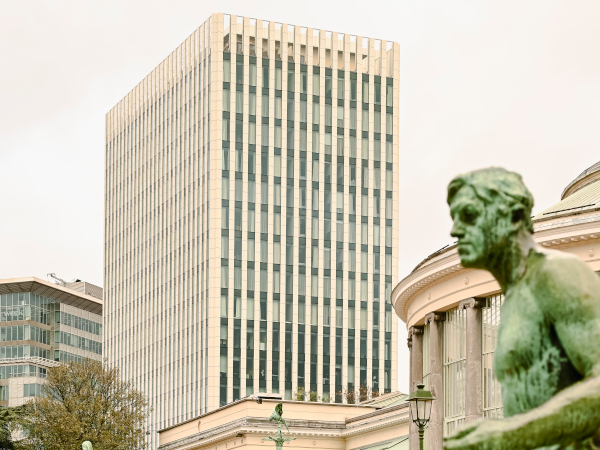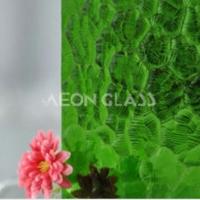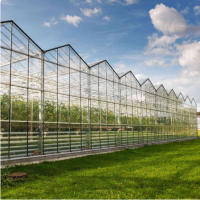Date: 28 April 2015
Designed by local artist Rick Vermey, Spectrum represents a refreshing change of direction from current material use within the public art landscape in Perth, delivering a stunning, multi-coloured feather in the cap for Qube Property Group’s latest boutique development, The Wexford.Combining the Vanceva Colour System and ImagInk Printed Glass, together with perforated sheet metal in lenticular façade with a saw-toothed configuration, Spectrum showcases a flowing kaleidoscope of colour and light at street level. ‘The faceting enables a shifting presence to the artwork, in that it only fully reveals itself gradually.The appearance is always changing as the ambient light changes, and as a pedestrian walks by its full length’ says Rick, ‘I was aiming to create an artwork that can be experienced over time, with the aid of movement and light properties.’
.jpg)
The 3.1m high toughened laminated panels are back-lit with powerful LED lights at night, throwing colour and dynamic shadows across the streetscape to create a multi-coloured light show that would makes Rio’s Carnival look like a still from a black and white movie. ‘At night, shadows of the ink patterns are projected on the footpath, and those reversed letters appear “printed” the correct way around, reflecting the old lead-set type printing method’ continues Rick. ‘The artwork title is a dual reference to the ephemeral phenomenon of light mixing into a spectrum of colours within the building by day, and out on the street after dark, along with a nod to the historical diversity of the vibrant Subiaco community.’
.jpg)
QUBE’s forward thinking approach towards public art was pivotal in developing and incorporating such a dynamic and visually arresting component within the project. It is a superb demonstration of a talented artist and open minded developer successfully engaging to deliver a technically challenging and industry leading installation. The end result is a visual feast, utilising the Vanceva colour system and ImagInk digital ceramic fritting to well and truly raise the bar for future public art installations within commercial developments.
‘The Artwork created by Rick for our Wexford Apartments in Perth has added a unique feature for both the residents of the development and the public’ comments Director of QUBE, Rhys Kelly. ‘During the day the printed coloured glass provides coloured light to the residents car park, and at night when backlit, bathes the footpath and the street with a multitude of colours.’
.jpg)
We put some questions to Rick regarding the project, and he was kind enough to answer them for us below.
The Wexford installation is exceptionally bright and vibrant with its eye popping full spectrum of colour – can you expand on the decision behind the use of the bright colours?
The inspiration for the artwork concept came from researching the history of the site, which once formed part of the old Government Print Works. I began speculating about various forms of printing through the ages, and the technological shift from past ink based communications to the digitally mediated backlit (screen-based) media of the future. At the same time, I developed a fascination for the remarkably original coloured leadlight glazing of many of Subiaco older homes.
By using light and coloured glass, I was able to generate a full spectrum of backlit colours. In a way it’s a form of contemporary homage to those old windows. In daylight hours the carpark interior is illuminated by hues of coloured sunlight. After dark that spectrum is projected onto the footpath outside. An interesting ephemeral phenomenon is the mixing of intermediary colours where one colour of light overlaps with another to create an additional blended colour that is not physically present.
What were the challenging aspects of working with glass and ceramic frit as a medium for this project?
The main challenge was in achieving different densities of frit opacity, in order to produce the illusion of layered depth to the glazing. That required some careful planning and testing. An additional challenge was to design a method for integrating alternate glazed and perforated sheet-metal panels into the same framing system, to allow for carpark ventilation. The resulting solution is seamless, thanks to a dependable install team.
Did you explore other methods of printing for the project, and why did you settle with the ceramic frit?
The key principle driving the materials selection for the project was to create an impression of depth or space between transparent colour (vanceva films) and opaque inks. Imagink was the most suitable candidate for the printing, as it sits “up” on one surface of the glass. Other lower cost methods either required print lamination or provided inferior colour saturation and transparency properties, for my purposes.
.jpg)
What kind of response has the installation elicited from council?
The Arts Development Officer is thrilled with the artwork, and very pleased to have it added to the City of Subiaco’s growing map of local public artworks.
What has the current feedback been like on Spectrum?
Feedback from the property developer, QUBE; the project architects, Eames; residents; neighbouring tenants; passersby; construction workers; and art world colleagues; has been resoundingly positive. I’ve even had congratulatory phone calls from people who just stumbled upon it by chance. People are mostly excited, to see such generous splashes of colour in public space, enlivening the streetscape.
What was the inspiration behind the faceted aspect of the glazing and the parallax style effect that occurs as you approach the artwork?
The faceted aspect was motivated by an objective to produce a changing facade to the artwork, with different faces visible at opposite ends of the street. The design is lenticular in plan view, with a saw-toothed configuration. I was aiming to create an artwork that can be experienced over time, with the aid of movement and light properties. From the east end it appears to be made of colourfully painted strips of perforated metal sheeting. From the west it is a broad and vivid celebration of colour, with faint hints of discernable photographic images printed over the glass.
The graphics are derived from historical photographs of the surrounding Subiaco district. Heavily abstracted by large halftone dot-patterns, those pictures are barely discernable, their content not immediately identifiable. The faceting enables a shifting presence to the artwork, in that it only fully reveals itself gradually. Its appearance is always changing as the ambient light changes, and as a pedestrian walks by its full length. The artwork is notably different in its qualities from day into night.
.jpg)
PROJECT DETAILS
‘Spectrum’ can be seen on Sheen St in Subiaco.
Client Rick Vermey Location Subiaco, Perth, Western Australia
Glass 13.52mm Toughened Low Iron Volume 47qm Printed Glass
Processing ImagInk ceramic printing, Vanceva Colour System, Custom Laminating
Further information on the processes featured in this project can be found below:



















Add new comment